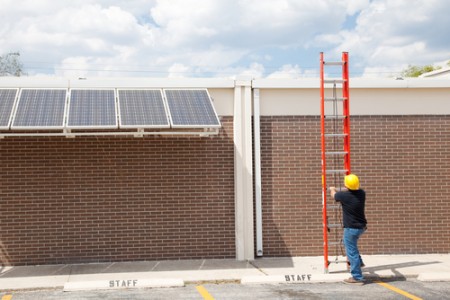By Pierre Bull, Natural Resources Defense Council
The U.S. solar industry employs more than 100,000 Americans and is expanding at a rate of 6.8 percent, helping to lift U.S. employment levels and the broader economy. In addition, almost 9 out of every 10 Americans say they want more solar development to boost domestic energy resources. Solar PV costs have fallen so rapidly that it now pays to be your own energy generator (with double the rewards when combined with appliance and building energy efficiency measures). Whether you’re a business, community institution, homeowner or even a renter, solar provides us all a new choice to take control of rising energy costs, prevent local pollution and avoid greenhouse gas emissions.

If my ‘sunny’ disposition as an environmental voice on the rise of solar energy isn’t convincing enough, check out these remarks from the President and CEO of one of the largest power suppliers in the U.S., NRG Energy Inc. In a conference call [subscription req’d] to company investors last week, NRG Energy, Inc.’s President and CEO David Crane remarked that the falling cost of solar could revolutionize utility industry:
We will be in a situation where within two years the price of delivered power from solar installations will be able to undercut the retail price of grid power in roughly 20 states,” Crane said. “Many of these high price retail states are in our core regions. This low-cost solar power, installed in ever-increasing volumes on a distributed and semi-distributed basis in a way that obviates the need for a lot of very long high-voltage transmission lines, has a potential to revolutionize the hub-and-spoke power system which currently makes up the American power industry.
Which 20 states is Mr. Crane referring to? Most likely the states and locales that are shaded in green in the graphic below. The National Renewable Energy Lab (NREL) created this map after running a basic level analysis that overlayed the national average cost for small-scale rooftop solar projects purchased through long-term, low-interest financing on top of local utility, state and federal incentives.
Solar energy’s mass appeal and solid investment features are beginning to pay off in a big way. Our own NRDC Renewable Energy Map shows that new solar energy facilities (of capacity size greater than 500 kW) are rapidly sprouting up throughout the U.S.
Paul Krugman summed things up nicely in his recent Op-Ed in the New York Times on the rise of solar energy amidst the Solyndra DOE loan guarantee fall-out:
… These days, mention solar power and you’ll probably hear cries of “Solyndra!” Republicans have tried to make the failed solar panel company both a symbol of government waste — although claims of a major scandal are nonsense — and a stick with which to beat renewable energy.
But Solyndra’s failure was actually caused by technological success: the price of solar panels is dropping fast, and Solyndra couldn’t keep up with the competition. In fact, progress in solar panels has been so dramatic and sustained that, as a blog post at Scientific American put it, “there’s now frequent talk of a ‘Moore’s law’ in solar energy,” with prices adjusted for inflation falling around 7 percent a year.
This has already led to rapid growth in solar installations, but even more change may be just around the corner. If the downward trend continues — and if anything it seems to be accelerating — we’re just a few years from the point at which electricity from solar panels becomes cheaper than electricity generated by burning coal.
Solar energy is now a major player among the expanding portfolio of clean and renewable energy options available in the U.S. The smoke and resulting shadow cast upon U.S. renewable energy industries from Solyndra’s fall out has dissipated. The sun is back, shining as brightly as it has been for billions of years, able to reinvigorate any economy that’s willing to let it.
![]() Editor’s Note: This column comes to us as a cross post courtesy of Natural Resources Defense Council. Author credit for the column goes to Pierre Bull.
Editor’s Note: This column comes to us as a cross post courtesy of Natural Resources Defense Council. Author credit for the column goes to Pierre Bull.